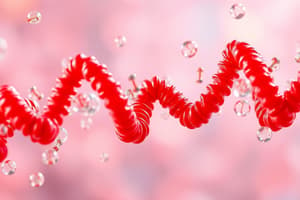Podcast
Questions and Answers
What does Vmax indicate in enzyme kinetics?
What does Vmax indicate in enzyme kinetics?
- The turnover number of an enzyme when fully saturated with substrate. (correct)
- The rate of enzyme degradation over time.
- The minimum amount of product formed by the enzyme.
- The maximum substrate concentration an enzyme can handle.
How do competitive inhibitors affect Km and Vmax?
How do competitive inhibitors affect Km and Vmax?
- Km decreases and Vmax remains the same.
- Km remains unchanged while Vmax decreases.
- Km increases and Vmax remains the same. (correct)
- Both Km and Vmax remain unchanged.
What characterizes noncompetitive inhibitors in relation to enzyme kinetics?
What characterizes noncompetitive inhibitors in relation to enzyme kinetics?
- They increase both Km and Vmax.
- They directly compete with the substrate for the active site.
- They change the enzyme shape without affecting substrate binding. (correct)
- They have no effect on enzyme activity.
In a Lineweaver-Burk plot, what remains the same with a competitive inhibitor?
In a Lineweaver-Burk plot, what remains the same with a competitive inhibitor?
What is the typical turnover number range for most enzymes?
What is the typical turnover number range for most enzymes?
Which aspect of enzyme kinetics is affected by noncompetitive inhibitors?
Which aspect of enzyme kinetics is affected by noncompetitive inhibitors?
Which of the following describes the effect of increasing substrate concentration in the presence of a competitive inhibitor?
Which of the following describes the effect of increasing substrate concentration in the presence of a competitive inhibitor?
What is the primary role of the Lineweaver-Burk plot in studying enzyme kinetics?
What is the primary role of the Lineweaver-Burk plot in studying enzyme kinetics?
What role do enzymes play in biological reactions?
What role do enzymes play in biological reactions?
What is Km in enzyme kinetics?
What is Km in enzyme kinetics?
What does a high Km value indicate about an enzyme's substrate binding?
What does a high Km value indicate about an enzyme's substrate binding?
Which factor does NOT influence the value of Km for an enzyme?
Which factor does NOT influence the value of Km for an enzyme?
What type of enzyme is Alkaline Phosphatase?
What type of enzyme is Alkaline Phosphatase?
What is Vmax in enzyme catalysis?
What is Vmax in enzyme catalysis?
Which of the following statements about enzyme structure is true?
Which of the following statements about enzyme structure is true?
How is the velocity of an enzyme-catalyzed reaction typically monitored in a lab setting?
How is the velocity of an enzyme-catalyzed reaction typically monitored in a lab setting?
Flashcards are hidden until you start studying
Study Notes
Enzymes
- Enzymes are biological catalysts that speed up chemical reactions in cells by factors of up to 10^20.
- Most enzymes are globular proteins, with the exception of catalytic RNA.
- Enzymes have active sites, which are pockets in their three-dimensional structure that bind to substrates and facilitate reactions.
Enzyme Kinetics
- Enzyme kinetics studies the rate of enzyme-catalyzed reactions, which are influenced by factors like pH, temperature, and ionic strength.
- Key parameters in enzyme kinetics include:
- Km: The substrate concentration at which the reaction rate is half of the maximum velocity (Vmax). A high Km indicates a lower binding affinity between the enzyme and substrate.
- Vmax: The maximum velocity of the reaction, representing the enzyme's turnover number (number of substrate molecules converted per unit time when fully saturated). A low Vmax indicates a slower conversion rate.
Inhibitors
- Inhibitors are molecules that can reduce or block enzyme activity.
- Competitive inhibitors bind to the active site of the enzyme, competing with the substrate for binding. They increase Km but do not affect Vmax.
- Noncompetitive inhibitors bind to an allosteric site on the enzyme, causing a conformational change that alters the active site. They decrease Vmax but do not affect Km.
Lineweaver-Burk Plot
- A Lineweaver-Burk plot is a double reciprocal plot of the Michaelis-Menten equation, which helps to determine Km and Vmax from enzymatic data.
- Competitive inhibitors show a different slope on a Lineweaver-Burk plot compared to the uninhibited reaction, but the Y-intercept remains the same.
- Noncompetitive inhibitors show a different Y-intercept on a Lineweaver-Burk plot compared to the uninhibited reaction, but the slope remains the same.
Studying That Suits You
Use AI to generate personalized quizzes and flashcards to suit your learning preferences.




